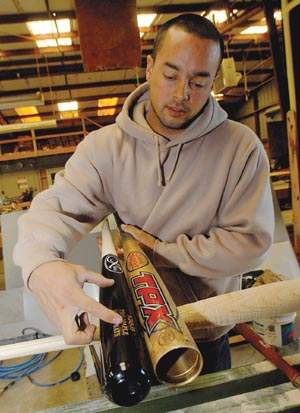
Due to recent events, the metal bat controversy in high school
baseball is once again at the forefront
HOLLISTER
Some may still consider it a freak occurrence, and perhaps rightfully so.
An early-March scrimmage against De La Salle took a tragic turn when Marin Catholic High School pitcher Gunnar Sandberg was nearly killed after being hit in the head with a line drive coming off a metal bat. The 16-year-old hurler suffered swelling of the brain shortly thereafter, and was put into a medically-induced coma as a result.
He didn’t wake from the coma for approximately two weeks, but recent reports have said Sandberg’s health is improving.
However freak or rare it was, though, the events that transpired on March 11 have only magnified what others feel is a growing concern within high school baseball, and have even stirred a bit of an uprising against metal bats in the state.
The Marin County Athletic League has already banned metal bats for the remainder of the season, while league representatives are even calling for the removal of metal bats from all playoff games in the North Coast Section.
Closer to home, last weekend’s 13-team Easter Tournament in Salinas was played strictly with wood bats — no metal — while this week’s Diamond Sports National Classic in Southern California, an elite tournament that Marin Catholic is competing in, opted to move to an all-wood format.
Even those line-drive come-backers that don’t happen too often are being put under a spotlight. Last Saturday, a Vanderbilt pitcher took a liner off the knee and broke his kneecap in the process, while the Salinas Californian reported on Wednesday a Pony League pitcher from King City took a line drive to the right eye and had to be rushed to the hospital as a result.
California Assemblyman Jared Huffman, who represents the 6th District, which includes Marin and parts of Sonoma counties, has even called for a three-year moratorium to ban non-wood bats from high school games throughout the state.
“Obviously with metal, it’s a safety issue,” San Benito manager Michael Luna said. “There’s been talk for a number of years for the collegiate level to go to the wood bat and at the high school level as well. High school usually follows the collegiate level.
“And it’s a big safety issue. But the problem, I believe, is cost.”
Cost was the main reason why certain levels of baseball began to switch from wood to metal bats in the first place, sometime around the 1970s. The development of the metal bat provided a cost-effective option for the lower levels of baseball, and allowed players and teams to purchase just a few bats that would last for years.
Wood bats, although more often cheaper in price, tended to break with a somewhat high rate of frequency, and players would need to buy several bats over the course of a single season.
But with players much larger and stronger than their 1970s counterparts, the pop a metal bat can provide may now be turning into a dangerous circumstance. A study reported by The Sporting News in June 2002 showed that a pitcher needs about four-tenths of a second to properly defend against a batted ball, which means the baseball would be traveling at approximately 97 mph.
And the difference in speeds can be as much as five mph greater off a metal bat than off a wooden one.
“Honestly, I think metal bats are very dangerous just because you are talking about a ball that comes off the bat at 150 miles per hour at a pitcher,” Gilroy manager Johnny Ramirez said.
“It’s a safety issue for me, too. I would hate to see one of my pitchers take one off the knee or off the head. That’s the dangerous part of it.”
While metal bats are being put under a microscope, opponents to the revolt feel that not only are come-backers rare, but the results of being hit by a line drive off a metal bat wouldn’t differ that much from a line drive off a wood bat.
And that may be true.
“But just as a pitcher, you feel a lot safer (against a wood bat),” said Jeremy Kirby, a pitcher who plays in the San Jose Men’s Senior Baseball League, which plays with both metal and wood bats, depending upon the age division.
Pitching against an imposing batter using a wood bat, Kirby said that the player is going to hit the ball hard anyway.
“But they’ve got to hit it just right,” he added.
Kirby, a Watsonville High graduate who previously played for Cabrillo College, used to run the Kirby Bat Co. for two years out of his Watsonville warehouse. He made bats out of either ash or maple, and said the “sweet spot” on a wood bat is roughly half the size on a metal bat.
“The percentage of hard-hit balls is gonna be a lot higher with (a metal bat),” said Kirby, who has been hit five times in his career while standing atop the mound.
He fractured and chipped his ankle bone once when he delivered a high fastball to a batter with a metal bat, and in high school, he took a liner off his foot that kept him out for two weeks.
While the cost of wood bats is not expected to decrease — and if the ban of metal bats is more widespread, the cost of wood bats could actually increase, Kirby said — the former bat maker noted that today’s wood bats can be made with stronger materials, including bamboo.
Composite wood bats, moreover, can be made with carbon fibers to reinforce the bat, while some companies even offer warranties against breakage.
Today, metal bats can cost upwards of $350 to $450, but can last one to three years. Wood bats can cost anywhere around $60 to $75, but can shatter or break on any given swing. Although nearly all players in high school purchase and use their own bats, a move to wood would likely put pressure on the school to help purchase some of the bats at a time when schools are looking to cut costs.
Many area coaches seem to be in favor of a move to wood — Luna said San Benito often uses wood bats during batting practice — but funding and cost, like it did in the 1970s, remains the issue.
“They are not an inexpensive thing to have,” Ramirez said. “A $400 metal bat is going to last you two, three years. A wood bat, maybe two, three games. So if there is funding for it, by all means. Let’s go to a wood bat and really make these games competitive.”









